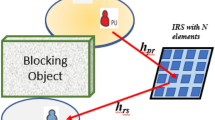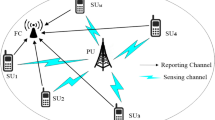Abstract
We investigate the performance of receiver diversity techniques by considering energy detector based optimal spectrum sensing in cognitive radio networks over Rayleigh fading channel for both non-cooperative and cooperative communication systems. The analysis is first focused on the non-cooperative spectrum sensing part, including the analyses of selection combining (SC), equal gain combining (EGC), and maximal ratio combining (MRC) receiver diversity systems. We derive exact closed-form expressions for the optimal detection thresholds for each diversity scheme. By using these expressions, we present their detection performance compared to the no-diversity case. Then in the second part of this paper, the performance analysis of the proposed system is investigated for amplify-and-forward relaying spectrum sensing with SC, EGC, and MRC diversity techniques in Rayleigh fading channels. Particularly, average detection probability of end-to-end signal-to-noise ratio for SC and EGC schemes and the exact closed-form expressions of the optimal detection threshold for SC, EGC, and MRC schemes are derived. We also present detection performance for the cooperative system compared to the non-cooperative one. The analyses are validated by simulated receiver operating characteristic curves.








Similar content being viewed by others
References
Yucek, T., & Arslan, H. (2009). A survey of spectrum sensing algorithms for cognitive radio applications. IEEE Communications Surveys and Tutorials, 11(1), 116–130.
Ma, J., Li, G. Y., & Juang, B. H. (2009). Signal processing in cognitive radio. Proceedings of the IEEE, 97(5), 805–823.
Letaief, K. B., & Zhang, W. (2009). Cooperative communications for cognitive radio networks. Proceedings of the IEEE, 97(5), 878–893.
Laneman, V., Tse, D., & Wornell, G. (2004). Cooperative diversity in wireless networks: Efficient protocols and outage behavior. IEEE Transactions on Information Theory, 50(12), 3062–3080.
Digham, F. F., Alouini, M. S., & Simon, M. K. (2003). On the energy detection of unknown signals over fading channels. In 38th IEEE international conference on communications (pp. 3375–3379). Alaska, USA.
Herath, S. P., & Rajatheva, N. (2008). Analysis of equal gain combining in energy detection for cognitive radio over Nakagami channels. In IEEE global communications conference. New Orleans, USA.
Pandharipande, A., & Linnartz, J. M. G. (2007). Performance analysis of primary user detection in a multiple antenna cognitive radio. In IEEE international conference on communications (pp. 6482–6486). Glasgow, Scotland.
Atapattu, S., Tellambura, C., & Jiang, H. (2009). Relay based cooperative spectrum sensing in cognitive radio networks. In IEEE global communications conference (pp. 1–5). Hawaii, USA.
Atapattu, S., Tellambura, V., & Jiang, H. (2011). Energy detection based cooperative spectrum sensing in cognitive radio networks. IEEE Transactions on Wireless Communications, 10(4), 1232–1241.
Sanguanpuak, V., Rajatheva, V., Taparugssanagom, A., & Alvest, H. (2012). Performance of energy detector over Nakagami-m fading for relay-based cognitive radio networks. In Proceedings of the ISWCS (pp. 546–550). Paris, France.
Atapattu, S., Tellambura, C., & Jiang, H. (2011). Spectrum sensing in low SNR: Diversity combining and cooperative communications. In Proceedings of the 6th IEEE ICIIS (pp. 13–17). Kandy, Sri Lanka.
Olabiyi, O., & Annamalai, V. (2011). Analysis of cooperative relay-based energy detection of unknown deterministic signals in cognitive radio networks. Chengdu: IWCN.
Mughal, M. O., Razi, A., & Kim, J. (2013). Tight upper bounds on average detection probability in cooperative relay networks with selection combiner. Transactions on Emerging Telecommunications Technologies. doi:10.1002/ett.2649.
Atapattu, S., Tellambura, C., & Jiang, H. (2011). Spectrum sensing via energy detector in low SNR. In IEEE International Conference on Communications (pp. 1–5). Kyoto, Japan.
Ilhan, H., & Akin, A. I. (2012). Performance analysis of AF relaying cooperative systems with relay selection over double Rayleigh Fading channels. In Proceedings of the 7th IEEE ICSPCS (pp. 1–6). Gold Cost, Australia.
Ikki, S. S., & Ahmed, M. H. (2009). Performance of cooperative diversity using equal gain combining (EGC) over Nakagami-m fading channels. IEEE Transactions on Wireless Communications, 8(2), 557–562.
Waqar, O., MacLernon, D. C., & Ghogho, M. (2009). Performance analysis of non-regenerative opportunistic relaying in Nakagami-m fading. In 20th IEEE international symposium on personal, indoor and mobile radio communications (pp. 231–235). Tokyo, Japan.
Joshi, D. R., Popescu, D. C., & Dobre, O. A. (2011). Gradient based threshold adaptation for energy detector in cognitive radio systems. IEEE Communications Letters, 15(1), 19–21.
Namdar, M., Ilhan, H., & Durak-Ata, L. (2014). Dispersed chirp-z transform-based spectrum sensing and utilization in cognitive radio networks. IET Signal Processing, 8(4), 320–329.
Karagiannidis, G. K., & Lioumpas, A. S. (2007). An improved approximation for the Gaussian Q-function. IEEE Communications Letters, 11(8), 644–646.
Gradshteyn, I. S., & Ryzhik, I. M. (2007). Table of integrals, series and products (7th ed.). San Diego: Academic Press.
Abramowitz, M., & Stegun, I. A. (1970). Handbook of mathematical functions with formulas, graphs, and mathematical tables (9th ed.). Washington, DC: National Bureau of Standards.
Nuttall, A. H. (1974). Some integrals involving QM-functions, New London, Connecticut: Naval Underwater Systems Center (NUSC) technical report.
Wolfram Research http://functions.wolfram.com. Accessed 3 March, 2014.
Gore, D. A., & Paulraj, A. J. (2002). MIMO antenna subset selection with space–time coding. IEEE Transactions on Signal Processing, 50(10), 2580–2588.
Simon, M. K., & Alouini, M. S. (2000). Digital communication over fading channels: A unified approach to performance analysis (2nd ed.). New York: Wiley.
Author information
Authors and Affiliations
Corresponding author
Ethics declarations
Conflict of interest
The authors declare that there are no competing interests.
Rights and permissions
About this article
Cite this article
Namdar, M., Ilhan, H. & Durak-Ata, L. Optimal Detection Thresholds in Spectrum Sensing with Receiver Diversity. Wireless Pers Commun 87, 63–81 (2016). https://doi.org/10.1007/s11277-015-3026-6
Published:
Issue Date:
DOI: https://doi.org/10.1007/s11277-015-3026-6




